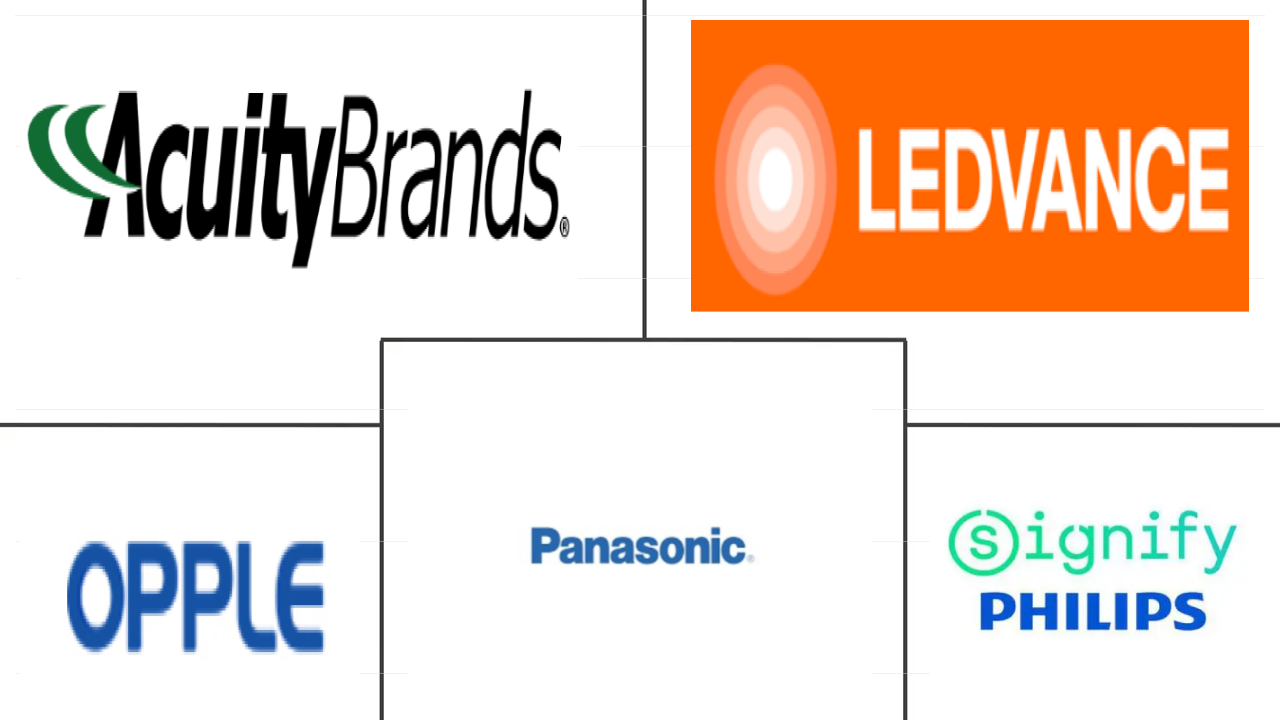Market Size of indoor led lighting Industry
| Icons | Lable | Value |
|---|---|---|
|
|
Study Period | 2017 - 2030 |
|
|
Market Size (2024) | USD 26.63 Billion |
|
|
Market Size (2030) | USD 36.35 Billion |
|
|
Largest Share by Indoor Lighting | Industrial and Warehouse |
|
|
CAGR (2024 - 2030) | 5.32 % |
|
|
Largest Share by Region | Asia-Pacific |
|
|
Market Concentration | Low |
Major Players |
||

|
||
|
*Disclaimer: Major Players sorted in no particular order |
Indoor LED Lighting Market Analysis
The Indoor LED Lighting Market size is estimated at 26.63 billion USD in 2024, and is expected to reach 36.35 billion USD by 2030, growing at a CAGR of 5.32% during the forecast period (2024-2030).
26.63 Billion
Market Size in 2024 (USD)
36.35 Billion
Market Size in 2030 (USD)
2.49 %
CAGR (2017-2023)
5.32 %
CAGR (2024-2030)
Largest Segment by Indoor Lighting
49.17 %
value share, Industrial and Warehouse, 2023
The GDP contribution of the manufacturing segment is around 16%. While only 12% of the industrial sector utilized LED lighting in 2017, it is projected to reach 90% by 2035.
Largest Segment by Commercial
30.54 %
value share, Retail, 2023
By 2023, the combination of online and in-store shopping experiences may become the norm for the retail industry. Approximately 53% of shoppers are more likely to purchase products online, thus increasing the retail sector's revenue.
Largest by Region
43.54 %
value share, Asia-Pacific, 2023
A surge in government initiatives to promote energy-efficient lighting systems, an increasing number of smart city projects, and the longevity of LED lights are driving the sector's growth.
Fastest-growing Segment by Region
6.23 %
Projected CAGR, Asia-Pacific, 2024-2030
The demand for lighting control requirements for indoor spaces like residential buildings is increasing at unanticipated rates as many homes are transitioning to smart home technologies.
Leading Market Player
13.84 %
market share, Signify (Philips), 2022

Signify Philips holds the largest market share. The company mostly focuses on newer innovations based on the energy-efficient portfolio, leading to major brand value recognition.
The increasing demand for industrial production, rising need for storage space, and increasing availability of office space drive the demand for indoor LED lighting market in the region
- In terms of value share, in 2023, industrial and warehouse (I&W) accounted for the majority of the share (49.2%), followed by commercial (31.1%), residential (17.5%), and agricultural. The market share is expected to gain in (I&W) and agricultural lighting in coming years and a small reduction in the remaining divisions. Across the globe, industries faced several internal and external headwinds during COVID-19. A large number of countries sustained their industrial production in 2021. In 2021, the United States produced a total of USD 2,497.1 billion, an increase of 11.55% compared to 2020. During the same period, the UK produced a total of USD 274.87 billion, an increase of 16.57% compared to 2020. Thus, the growing industrial production resulted in creating more need for warehouses and increasing the demand for indoor lighting in coming years.
- Government subsidies and housing schemes play a key role in the adoption of new houses in many nations. In India, the government has introduced several energy-saving programs. For example, the central government's ambitious Pradhan Mantri Awas Yojana (PMAY) program aimed to build 20 million affordable metropolitan housing units nationwide by 2022. In Calgary, Canada, under multi-units, home projects fueled 17,306 starts in 2022.
- E-commerce and the export boom have led to demand for new warehouses and other logistics infrastructure, and logistics-related building is becoming an increasingly important sector. In July 2022, Yum China Holdings Inc. commenced the construction of the Yum China Supply Chain Management Center in Shanghai's Jiading district, with an area of 61,000 square meters. Such instances are expected to drive the growth of the global indoor LED market.
Rising e-commerce, home ownership, and smart city development across the world would boost LED light sales
- In terms of value and volume share, Asia-Pacific has the majority share in indoor LED lighting. In terms of value share, in 2023, APAC stood second after North America, followed by Europe, the Middle East & Africa, and South America. In 2021, in APAC, China's output value totaled USD 486.58 billion, an increase of 26.04% compared to 2020. In 2022, industrial production increased by 3.6%. In March 2023, China's industrial production increased by 3.9% year-on-year. Thus, post-pandemic increases in industrial output will lead to demand for indoor lighting in the coming years.
- Furthermore, in North America, by 2022, most US startups were expected to be retail-focused (15.05%), including both brick-and-mortar stores and one e-commerce company. Restaurants and other food businesses followed, accounting for 13.71% of new businesses. An increase in the number of startups is expected to increase the demand for indoor LEDs in the region.
- Additionally, in Europe, between 2017 and 2020, the German homeownership rate declined slightly. About 49.1% of the population lived in apartments in 2021 and 46.7% in 2022. As a result, Germany has the lowest homeownership rate in Europe and one of the largest rental apartment markets. Inflation and high-interest rates have pushed home prices to their steepest quarterly decline in 16 years. Urban and rural homes and apartments fell an average of 3.6%. New home construction is expected to decline next year. Overall, the growth rate of demand for LED lighting may fluctuate depending on home sales demand, but growth in rental housing could accelerate LED adoption in the country.
Indoor LED Lighting Industry Segmentation
Agricultural Lighting, Commercial, Industrial and Warehouse, Residential are covered as segments by Indoor Lighting. Asia-Pacific, Europe, Middle East and Africa, North America, South America are covered as segments by Region.
- In terms of value share, in 2023, industrial and warehouse (I&W) accounted for the majority of the share (49.2%), followed by commercial (31.1%), residential (17.5%), and agricultural. The market share is expected to gain in (I&W) and agricultural lighting in coming years and a small reduction in the remaining divisions. Across the globe, industries faced several internal and external headwinds during COVID-19. A large number of countries sustained their industrial production in 2021. In 2021, the United States produced a total of USD 2,497.1 billion, an increase of 11.55% compared to 2020. During the same period, the UK produced a total of USD 274.87 billion, an increase of 16.57% compared to 2020. Thus, the growing industrial production resulted in creating more need for warehouses and increasing the demand for indoor lighting in coming years.
- Government subsidies and housing schemes play a key role in the adoption of new houses in many nations. In India, the government has introduced several energy-saving programs. For example, the central government's ambitious Pradhan Mantri Awas Yojana (PMAY) program aimed to build 20 million affordable metropolitan housing units nationwide by 2022. In Calgary, Canada, under multi-units, home projects fueled 17,306 starts in 2022.
- E-commerce and the export boom have led to demand for new warehouses and other logistics infrastructure, and logistics-related building is becoming an increasingly important sector. In July 2022, Yum China Holdings Inc. commenced the construction of the Yum China Supply Chain Management Center in Shanghai's Jiading district, with an area of 61,000 square meters. Such instances are expected to drive the growth of the global indoor LED market.
| Indoor Lighting | |||||
| Agricultural Lighting | |||||
| |||||
| Industrial and Warehouse | |||||
| Residential |
| Region | |
| Asia-Pacific | |
| Europe | |
| Middle East and Africa | |
| North America | |
| South America |
Indoor LED Lighting Market Size Summary
The indoor LED lighting market is poised for significant growth, driven by increasing demand across various sectors such as industrial, commercial, and residential. The market is experiencing a shift in value share, with industrial and warehouse lighting currently holding the largest portion, followed by commercial and residential sectors. The post-pandemic recovery in industrial production, particularly in regions like Asia-Pacific and North America, is expected to bolster the demand for indoor LED lighting. Government initiatives and subsidies, especially in countries like India, are further propelling the adoption of energy-efficient lighting solutions. The rise in e-commerce and logistics infrastructure is also contributing to the market's expansion, as new warehouses and logistics facilities require advanced lighting solutions.
Globally, the market is characterized by a fragmented landscape with key players such as Acuity Brands Inc., LEDVANCE GmbH, OPPLE Lighting Co. Ltd, Panasonic Holdings Corporation, and Signify (Philips) leading the charge. The development of smart cities and green buildings, particularly in North America, is enhancing the adoption of LED lighting due to its energy efficiency and sustainability benefits. In Europe, regulatory changes are phasing out inefficient lighting sources, further boosting the demand for LEDs. The market's growth is also supported by innovations in LED technology, with companies like Osram and Aculux introducing advanced products designed for specific applications. As the global population and employment rates rise, the need for efficient and sustainable lighting solutions is expected to increase, driving the market forward.
Indoor LED Lighting Market Size - Table of Contents
-
1. MARKET SEGMENTATION (includes market size in Value in USD and Volume, Forecasts up to 2030 and analysis of growth prospects)
-
1.1 Indoor Lighting
-
1.1.1 Agricultural Lighting
-
1.1.2 Commercial
-
1.1.2.1 Office
-
1.1.2.2 Retail
-
1.1.2.3 Others
-
-
1.1.3 Industrial and Warehouse
-
1.1.4 Residential
-
-
1.2 Region
-
1.2.1 Asia-Pacific
-
1.2.2 Europe
-
1.2.3 Middle East and Africa
-
1.2.4 North America
-
1.2.5 South America
-
-
Indoor LED Lighting Market Size FAQs
How big is the Global Indoor LED Lighting Market?
The Global Indoor LED Lighting Market size is expected to reach USD 26.63 billion in 2024 and grow at a CAGR of 5.32% to reach USD 36.35 billion by 2030.
What is the current Global Indoor LED Lighting Market size?
In 2024, the Global Indoor LED Lighting Market size is expected to reach USD 26.63 billion.

